Resistive Switching Behavior of Sol–Gel-Processed ZnMgO/ZnO Bilayer in Optoelectronic Devices
Abstract
1. Introduction
2. Materials and Methods
3. Results and Discussion
4. Conclusions
Supplementary Materials
Author Contributions
Funding
Data Availability Statement
Acknowledgments
Conflicts of Interest
References
- Kim, J. Recent progresses and challenges in colloidal quantum dot light-emitting diodes: A focus on electron transport layers with metal oxide nanoparticles and organic semiconductors. Nanoscale Horiz. 2024, 9, 2167–2197. [Google Scholar] [CrossRef]
- Ali, A.; Jiang, W.; Choi, Y.; Jeon, E.; Chae, H. Enhanced charge balance with antibiotics in both electron and hole transport layers of InP/ZnSexS1–x/ZnS-based quantum dot light-emitting diodes. J. Alloys Compd. 2022, 900, 163449. [Google Scholar] [CrossRef]
- Chen, T.; Yu, K.; Hu, H.; Li, Y.; Huang, W.; Li, R.; Qie, Y.; Lin, H.; Guo, T.; Li, F. Engineering Electron Transport Layer with Ionic Liquid for High-Performance Quantum Dot Light-Emitting Diodes. ACS Appl. Nano Mater. 2025, 8, 4573–4579. [Google Scholar] [CrossRef]
- He, S.; Zhang, S.; Wang, F.; Chen, L.; Li, Y.; Ruan, J.; Ouyang, X.; Du, X. Enhancement of the luminescence intensity of a ZnO:Ga crystal scintillator via coating CsPbBr3 quantum dot films. Opt. Mater. 2024, 148, 114955. [Google Scholar] [CrossRef]
- Uklein, A.V.; Multian, V.V.; Kuz’micheva, G.M.; Linnik, R.P.; Lisnyak, V.V.; Popov, A.I.; Gayvoronsky, V.Y. Nonlinear optical response of bulk ZnO crystals with different content of intrinsic defects. Opt. Mater. 2018, 84, 738–747. [Google Scholar] [CrossRef]
- Sun, H.D.; Makino, T.; Segawa, Y.; Kawasaki, M.; Ohtomo, A.; Tamura, K.; Koinuma, H. Enhancement of exciton binding energies in ZnO/ZnMgO multiquantum wells. J. Appl. Phys. 2002, 91, 1993–1997. [Google Scholar] [CrossRef]
- Su, Y.Q.; Zhu, Y.; Yong, D.; Chen, M.; Su, L.; Chen, A.; Wu, Y.; Pan, B.; Tang, Z. Enhanced Exciton Binding Energy of ZnO by Long-Distance Perturbation of Doped Be Atoms. J. Phys. Chem. Lett. 2016, 7, 1484–1489. [Google Scholar] [CrossRef]
- Saoud, F.S.; Plenet, J.C.; Henini, M. Band gap and partial density of states for ZnO: Under high pressure. J. Alloys Compd. 2015, 619, 812–819. [Google Scholar] [CrossRef]
- Wang, T.; Liu, Y.; Fang, Q.; Wu, M.; Sun, X.; Lu, F. Low temperature synthesis wide optical band gap Al and (Al, Na) co-doped ZnO thin films. Appl. Surf. Sci. 2011, 257, 2341–2345. [Google Scholar] [CrossRef]
- Yu, Y.; Liang, Y.; Yong, J.; Li, T.; Hossain, M.S.; Liu, Y.; Hu, Y.; Ganesan, K.; Skafidas, E. Low-Temperature Solution-Processed Transparent QLED Using Inorganic Metal Oxide Carrier Transport Layers. Adv. Funct. Mater. 2022, 32, 2106387. [Google Scholar] [CrossRef]
- Lee, T.; Hahm, D.; Kim, K.; Bae, W.K.; Lee, C.; Kwak, J. Highly Efficient and Bright Inverted Top-Emitting InP Quantum Dot Light-Emitting Diodes Introducing a Hole-Suppressing Interlayer. Small 2019, 15, 1905162. [Google Scholar] [CrossRef]
- Kirkwood, N.; Singh, B.; Mulvaney, P. Enhancing Quantum Dot LED Efficiency by Tuning Electron Mobility in the ZnO Electron Transport Layer. Adv. Mater. Interfaces 2016, 3, 1600868. [Google Scholar] [CrossRef]
- Yoon, S.-Y.; Lee, Y.-J.; Yang, H.; Jo, D.-Y.; Kim, H.-M.; Kim, Y.; Park, S.M.; Park, S.; Yang, H. Performance Enhancement of InP Quantum Dot Light-Emitting Diodes via a Surface-Functionalized ZnMgO Electron Transport Layer. ACS Energy Lett. 2022, 7, 2247–2255. [Google Scholar] [CrossRef]
- Chen, M.; Li, Q.; Bian, Y.; Wang, S.; Hu, B.; Tang, A.; Chen, F.; Lv, Y.; Shen, H. High-Efficiency and Stable Green InP-QLED Enabled by Lowering Electron Injection Barrier. Adv. Opt. Mater. 2025, 13, 2402555. [Google Scholar] [CrossRef]
- Kim, D.C.; Seung, H.; Yoo, J.; Kim, J.; Song, H.H.; Kim, J.S.; Kim, Y.; Lee, K.; Choi, C.; Jung, D.; et al. Intrinsically stretchable quantum dot light-emitting diodes. Nat. Electron. 2024, 7, 365–374. [Google Scholar] [CrossRef]
- Cao, F.; Wu, Q.; Zhang, S.; Yu, W.; Kong, L.; Yang, Y.; Zhang, J.; Wang, S.; Yang, X. Surface- and Spatial-Regulated Cd-Free Quantum Dots for Efficient, Mechanically Stable, and Full-Color Flexible Light-Emitting Diodes. Adv. Mater. 2025, 37, 2420575. [Google Scholar] [CrossRef] [PubMed]
- Bi, Y.; Sun, J.; Cao, S.; Li, Q.; Zheng, J.; Yuan, X.; Wang, Y.; Zou, B.; Zhao, J. Highly efficient and eco-friendly green quantum dot light-emitting diodes through interfacial potential grading. Nat. Commun. 2025, 16, 1945. [Google Scholar] [CrossRef] [PubMed]
- Won, Y.-H.; Cho, O.; Kim, T.; Chung, D.-Y.; Kim, T.; Chung, H.; Jang, H.; Lee, J.; Kim, D.; Jang, E. Highly efficient and stable InP/ZnSe/ZnS quantum dot light-emitting diodes. Nature 2019, 575, 634–638. [Google Scholar] [CrossRef]
- Chaudhary, A.; Shukla, R.K.; Malik, P.; Mehra, R.; Raina, K.K. ZnO/FLC nanocomposites with low driving voltage and non-volatile memory for information storage applications. Curr. Appl Phys. 2019, 19, 1374–1378. [Google Scholar] [CrossRef]
- Awasthi, S.; Pramanik, S.; Singh, K.K.; Mohan, A.; Pal, B.N. Highly Flexible Non-Volatile Resistive Memory Devices Based on ZnO Nanoparticle/Graphene Heterostructures Embedded in Poly(methyl methacrylate). ACS Appl. Nano Mater. 2024, 7, 6392–6400. [Google Scholar] [CrossRef]
- Chen, G.; Song, C.; Chen, C.; Gao, S.; Zeng, F.; Pan, F. Resistive Switching and Magnetic Modulation in Cobalt-Doped ZnO. Adv. Mater. 2012, 24, 3515–3520. [Google Scholar] [CrossRef] [PubMed]
- Patil, V.L.; Patil, A.A.; Patil, S.V.; Khairnar, N.A.; Tarwal, N.L.; Vanalakar, S.A.; Bulakhe, R.N.; In, I.; Patil, P.S.; Dongale, T.D. Bipolar resistive switching, synaptic plasticity and non-volatile memory effects in the solution-processed zinc oxide thin film. Mater. Sci. Semicond. Process. 2020, 106, 104769. [Google Scholar] [CrossRef]
- Park, Y.; Han, U.-B.; Kim, M.-K.; Lee, J.-S. Solution-Processed Flexible Threshold Switch Devices. Adv. Electron. Mater. 2018, 4, 1700521. [Google Scholar] [CrossRef]
- Carlos, E.; Branquinho, R.; Martins, R.; Kiazadeh, A.; Fortunato, E. Recent Progress in Solution-Based Metal Oxide Resistive Switching Devices. Adv. Mater. 2021, 33, 2004328. [Google Scholar] [CrossRef]
- Belmoubarik, M.; Al-Mahdawi, M.; Machado, G.; Nozaki, T.; Coelho, C.; Sahashi, M.; Peng, W.K. Resistive switching and Schottky barrier modulation at CoPt/ferroelectric-like MgZnO interface for non-volatile memories. J. Mater. Sci. Mater. Electron. 2024, 35, 460. [Google Scholar] [CrossRef]
- Zhang, H.; Alanthattil, A.; Webster, R.F.; Zhang, D.; Ghasemian, M.B.; Venkataramana, R.B.; Seidel, J.; Sharma, P. Robust Switchable Polarization and Coupled Electronic Characteristics of Magnesium-Doped Zinc Oxide. ACS Nano 2023, 17, 17148–17157. [Google Scholar] [CrossRef]
- Kumar, M.; Dhar, J.C. Low interface state density and large capacitive memory window using RF sputtered NiO nanoparticles decorated MgZnO thin film. Sci. Rep. 2025, 15, 2322. [Google Scholar] [CrossRef]
- She, Y.; Peng, Y.; Tang, B.; Hu, W.; Qiu, J.; Tang, X.; Bao, D. Bipolar resistive switching effects with self-compliance and multilevel storage characteristics in Ag/MgZnO/Si structures. Ceram. Int. 2018, 44, S11–S14. [Google Scholar] [CrossRef]
- Heo, S.B.; Shin, J.S.; Kim, T.Y.; Park, S.; Jung, W.H.; Kim, H.; Hong, J.-A.; Kim, B.-S.; Park, Y.; Chin, B.D.; et al. Highly efficient and low turn-on voltage quantum-dot light-emitting diodes using a ZnMgO/ZnO double electron transport layer. Curr. Appl Phys. 2021, 29, 107–113. [Google Scholar] [CrossRef]
- Lee, K.; Lee, J.; Bae, Y.; Roh, H.; Jung, W.H.; Lim, J.; Kim, J.; Roh, J. Interfacial Modification of ZnO/ZnMgO Bilayer for Efficient and Stable InP Quantum Dot Light-Emitting Diodes via Ultraviolet Ozone Treatment. ACS Appl. Mater. Interfaces 2024, 16, 55658–55665. [Google Scholar] [CrossRef] [PubMed]
- Sun, Y.; Jiang, Y.; Peng, H.; Wei, J.; Zhang, S.; Chen, S. Efficient quantum dot light-emitting diodes with a Zn0.85Mg0.15O interfacial modification layer. Nanoscale 2017, 9, 8962–8969. [Google Scholar] [CrossRef]
- Chen, L.; Qin, Z.; Chen, S. Ultrahigh Resolution Pixelated Top-Emitting Quantum-Dot Light-Emitting Diodes Enabled by Color-Converting Cavities. Small Methods 2022, 6, 2101090. [Google Scholar] [CrossRef]
- Azeem, W.; Su, S.; Ho, L.P.; Younas, M.; Azad, F.; Rashid, R. Point contact bipolar resistive switching observed in transparent ZnMgO/ZnO:Ga heterostructure. J. Mater. Sci. Mater. Electron. 2019, 30, 7080–7086. [Google Scholar] [CrossRef]
- Chen, X.; Hu, W.; Wu, S.; Bao, D. Complementary switching on TiN/MgZnO/ZnO/Pt bipolar memory devices for nanocrossbar arrays. J. Alloys Compd. 2014, 615, 566–568. [Google Scholar] [CrossRef]
- Chen, X.; Hu, W.; Wu, S.; Bao, D. Stabilizing resistive switching performances of TiN/MgZnO/ZnO/Pt heterostructure memory devices by programming the proper compliance current. Appl. Phys. Lett. 2014, 104, 043508. [Google Scholar] [CrossRef]
- Yoon, J.-G. A New Approach to the Fabrication of Memristive Neuromorphic Devices: Compositionally Graded Films. Materials 2020, 13, 3680. [Google Scholar] [CrossRef] [PubMed]
- Ding, S.; Wu, Z.; Qu, X.; Tang, H.; Wang, K.; Xu, B.; Sun, X.W. Impact of the resistive switching effects in ZnMgO electron transport layer on the aging characteristics of quantum dot light-emitting diodes. Appl. Phys. Lett. 2020, 117, 093501. [Google Scholar] [CrossRef]
- Xia, Y.; He, W.; Chen, L.; Meng, X.; Liu, Z. Field-induced resistive switching based on space-charge-limited current. Appl. Phys. Lett. 2007, 90, 022907. [Google Scholar] [CrossRef]
- Deshmukh, A.P.; Patil, K.; Ogale, S.; Bhave, T. Resistive Switching in CsPbBr3 (0D)/MoS2 (2D) Heterojunction System: Trap-Controlled Space Charge Limited Transport Mechanism. ACS Appl. Electron. Mater. 2023, 5, 1536–1545. [Google Scholar] [CrossRef]
- Harada, T.; Ohkubo, I.; Tsubouchi, K.; Kumigashira, H.; Ohnishi, T.; Lippmaa, M.; Matsumoto, Y.; Koinuma, H.; Oshima, M. Trap-controlled space-charge-limited current mechanism in resistance switching at Al/Pr0.7Ca0.3MnO3 interface. Appl. Phys. Lett. 2008, 92, 222113. [Google Scholar] [CrossRef]
- Kim, D.; Bang, H.; Baac, H.W.; Lee, J.; Truong, P.L.; Jeong, B.H.; Appadurai, T.; Park, K.K.; Heo, D.; Nam, V.B.; et al. Room-Temperature-Processable Highly Reliable Resistive Switching Memory with Reconfigurability for Neuromorphic Computing and Ultrasonic Tissue Classification. Adv. Funct. Mater. 2023, 33, 2213064. [Google Scholar] [CrossRef]
- Sun, Y.; Han, C.; Li, R.; Xiang, C.; Zhang, T.; Qian, L. Fully solution-processed red tandem quantum dot light-emitting diodes with an EQE exceeding 35%. J. Mater. Chem. C 2024, 12, 10053–10060. [Google Scholar] [CrossRef]
- Sun, Y.; Seo, J.H.; Takacs, C.J.; Seifter, J.; Heeger, A.J. Inverted Polymer Solar Cells Integrated with a Low-Temperature-Annealed Sol-Gel-Derived ZnO Film as an Electron Transport Layer. Adv. Mater. 2011, 23, 1679–1683. [Google Scholar] [CrossRef] [PubMed]
- Luo, Y.; Peng, X.; Yu, S. MLP+NeuroSimV3.0: Improving On-chip Learning Performance with Device to Algorithm Optimizations. In Proceedings of the International Conference on Neuromorphic Systems, Association for Computing Machinery, Knoxville, TN, USA, 23–25 July 2019; pp. 1–7. [Google Scholar]
- Buckeridge, J.; Catlow, C.R.A.; Farrow, M.R.; Logsdail, A.J.; Scanlon, D.O.; Keal, T.W.; Sherwood, P.; Woodley, S.M.; Sokol, A.A.; Walsh, A. Deep vs shallow nature of oxygen vacancies and consequent n-type carrier concentrations in transparent conducting oxides. Phys. Rev. Mater. 2018, 2, 054604. [Google Scholar] [CrossRef]
- Lai, Y.; Xin, P.; Cheng, S.; Yu, J.; Zheng, Q. Plasma enhanced multistate storage capability of single ZnO nanowire based memory. Appl. Phys. Lett. 2015, 106, 031603. [Google Scholar] [CrossRef]
- Park, J.H.; Alshammari, F.H.; Wang, Z.; Alshareef, H.N. Interface Engineering for Precise Threshold Voltage Control in Multilayer-Channel Thin Film Transistors. Adv. Mater. Interfaces 2016, 3, 1600713. [Google Scholar] [CrossRef]
- Kim, J.; Jung, H.; Song, J.; Kim, K.; Lee, C. Analysis of Interfacial Layer-Induced Open-Circuit Voltage Burn-In Loss in Polymer Solar Cells on the Basis of Electroluminescence and Impedance Spectroscopy. ACS Appl. Mater. Interfaces 2017, 9, 24052–24060. [Google Scholar] [CrossRef]
- Eun, Y.-B.; Jang, G.-P.; Yang, J.-H.; Kim, S.-Y.; Chae, Y.-B.; Ha, M.-Y.; Moon, D.-G.; Kim, C.-K. Performance Improvement of Quantum Dot Light-Emitting Diodes Using a ZnMgO Electron Transport Layer with a Core/Shell Structure. Materials 2023, 16, 600. [Google Scholar] [CrossRef] [PubMed]
- Youn, W.; Lee, J.W.; Yu, H.; Kim, D.Y. Effect of Refractive Index Contrast on Out-Coupling Efficiency of Corrugated OLEDs using Low-Refractive-Index LiF Interlayer. ACS Appl. Electron. Mater. 2020, 2, 2218–2223. [Google Scholar] [CrossRef]
- Kwon, S.; Kim, M.-J.; Chung, K.-B. Multi-level characteristics of TiOx transparent non-volatile resistive switching device by embedding SiO2 nanoparticles. Sci. Rep. 2021, 11, 9883. [Google Scholar] [CrossRef]
- Huang, C.-Y.; Huang, C.-Y.; Tsai, T.-L.; Lin, C.-A.; Tseng, T.-Y. Switching mechanism of double forming process phenomenon in ZrOx/HfOy bilayer resistive switching memory structure with large endurance. Appl. Phys. Lett. 2014, 104, 062901. [Google Scholar] [CrossRef]
- Tsai, T.-L.; Chang, H.-Y.; Lou, J.J.-C.; Tseng, T.-Y. A high performance transparent resistive switching memory made from ZrO2/AlON bilayer structure. Appl. Phys. Lett. 2016, 108, 153505. [Google Scholar] [CrossRef]
- Mahata, C.; Kang, M.; Kim, S. Multi-Level Analog Resistive Switching Characteristics in Tri-Layer HfO2/Al2O3/HfO2 Based Memristor on ITO Electrode. Nanomaterials 2020, 10, 2069. [Google Scholar] [CrossRef]
- Popov, A.I.; Kotomin, E.A.; Maier, J. Basic properties of the F-type centers in halides, oxides and perovskites. Nucl. Instrum. Methods Phys. Res. Sect. B 2010, 268, 3084–3089. [Google Scholar] [CrossRef]
- McCluskey, M.D.; Jokela, S.J. Defects in ZnO. J. Appl. Phys. 2009, 106, 071101. [Google Scholar] [CrossRef]
- Ghorbani, A.; Chen, J.; Chun, P.; Lyu, Q.; Cotella, G.; Aziz, H. Changes in Hole and Electron Injection under Electrical Stress and the Rapid Electroluminescence Loss in Blue Quantum-Dot Light-Emitting Devices. Small 2024, 20, 2304580. [Google Scholar] [CrossRef]
- Lee, J.; Yang, K.; Kwon, J.Y.; Kim, J.E.; Han, D.I.; Lee, D.H.; Yoon, J.H.; Park, M.H. Role of oxygen vacancies in ferroelectric or resistive switching hafnium oxide. Nano Converg. 2023, 10, 55. [Google Scholar] [CrossRef] [PubMed]
- Su, Q.; Sun, Y.; Zhang, H.; Chen, S. Origin of Positive Aging in Quantum-Dot Light-Emitting Diodes. Adv. Sci. 2018, 5, 1800549. [Google Scholar] [CrossRef]
- Han, S.W.; Park, C.J.; Shin, M.W. The role of Al atoms in resistive switching for Al/ZnO/Pt Resistive Random Access Memory (RRAM) device. Surf. Interfaces 2022, 31, 102099. [Google Scholar] [CrossRef]
- Zhang, K.; Jia, X.; Cao, K.; Wang, J.; Zhang, Y.; Lin, K.; Chen, L.; Feng, X.; Zheng, Z.; Zhang, Z.; et al. High On/Off Ratio Spintronic Multi-Level Memory Unit for Deep Neural Network. Adv. Sci. 2022, 9, 2103357. [Google Scholar] [CrossRef]
- Choi, S.; Shin, J.; Park, G.; Eo, J.S.; Jang, J.; Yang, J.J.; Wang, G. 3D-integrated multilayered physical reservoir array for learning and forecasting time-series information. Nat. Commun. 2024, 15, 2044. [Google Scholar] [CrossRef] [PubMed]
- Castro, W.; Oblitas, J.; Santa-Cruz, R.; Avila-George, H. Multilayer perceptron architecture optimization using parallel computing techniques. PLoS ONE 2017, 12, e0189369. [Google Scholar] [CrossRef] [PubMed]
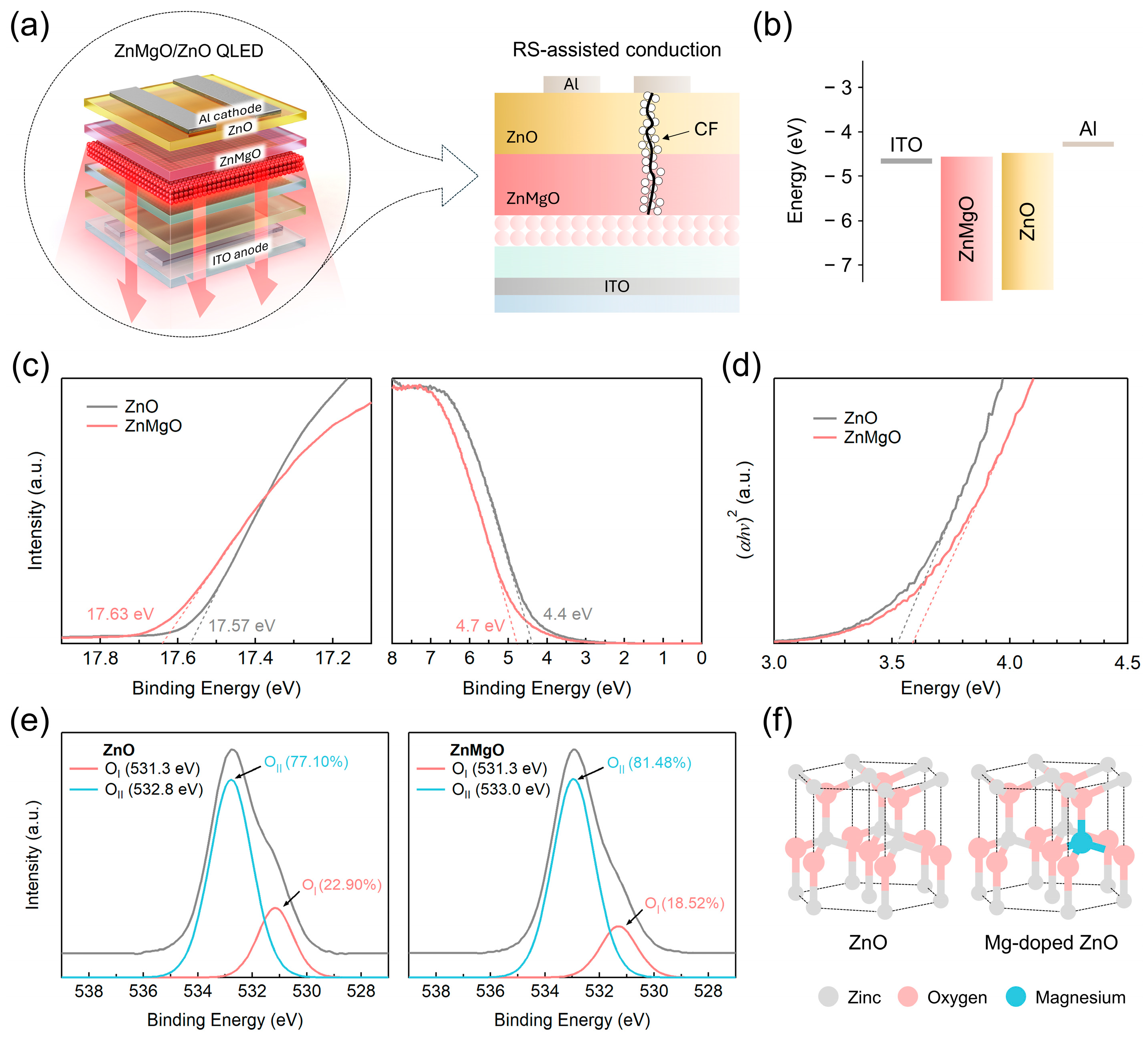
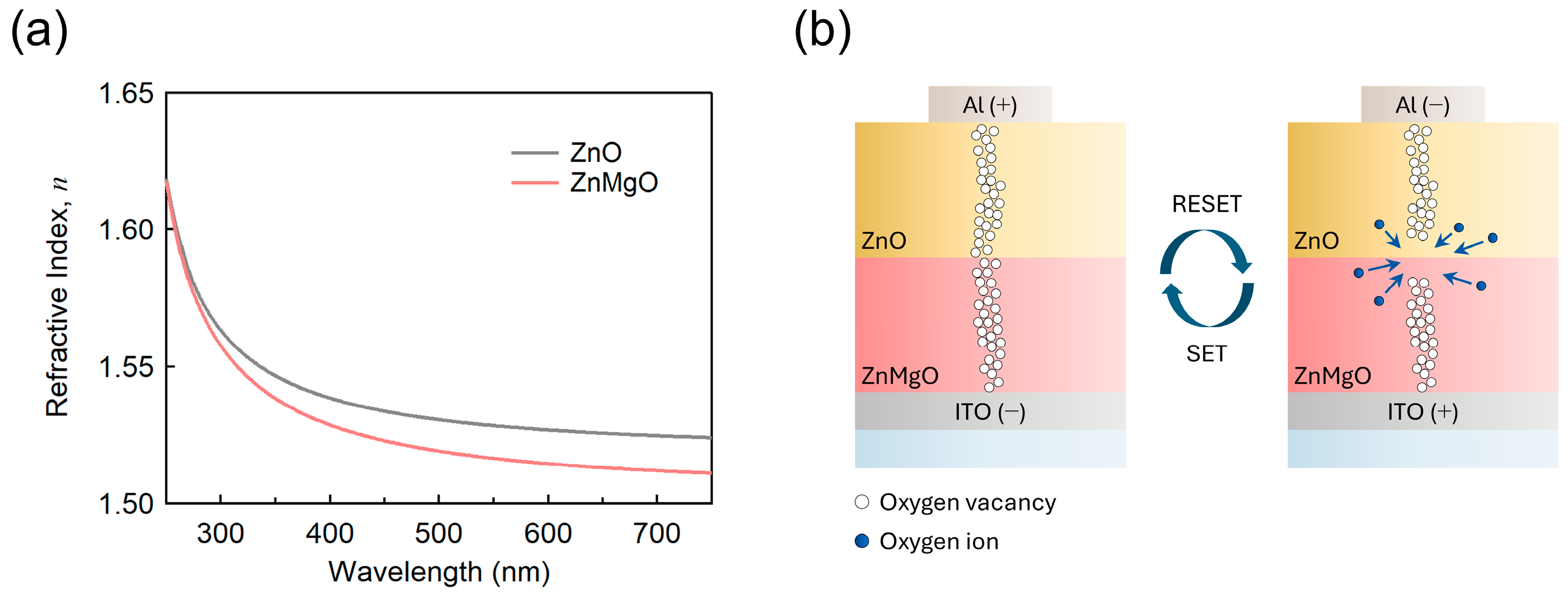

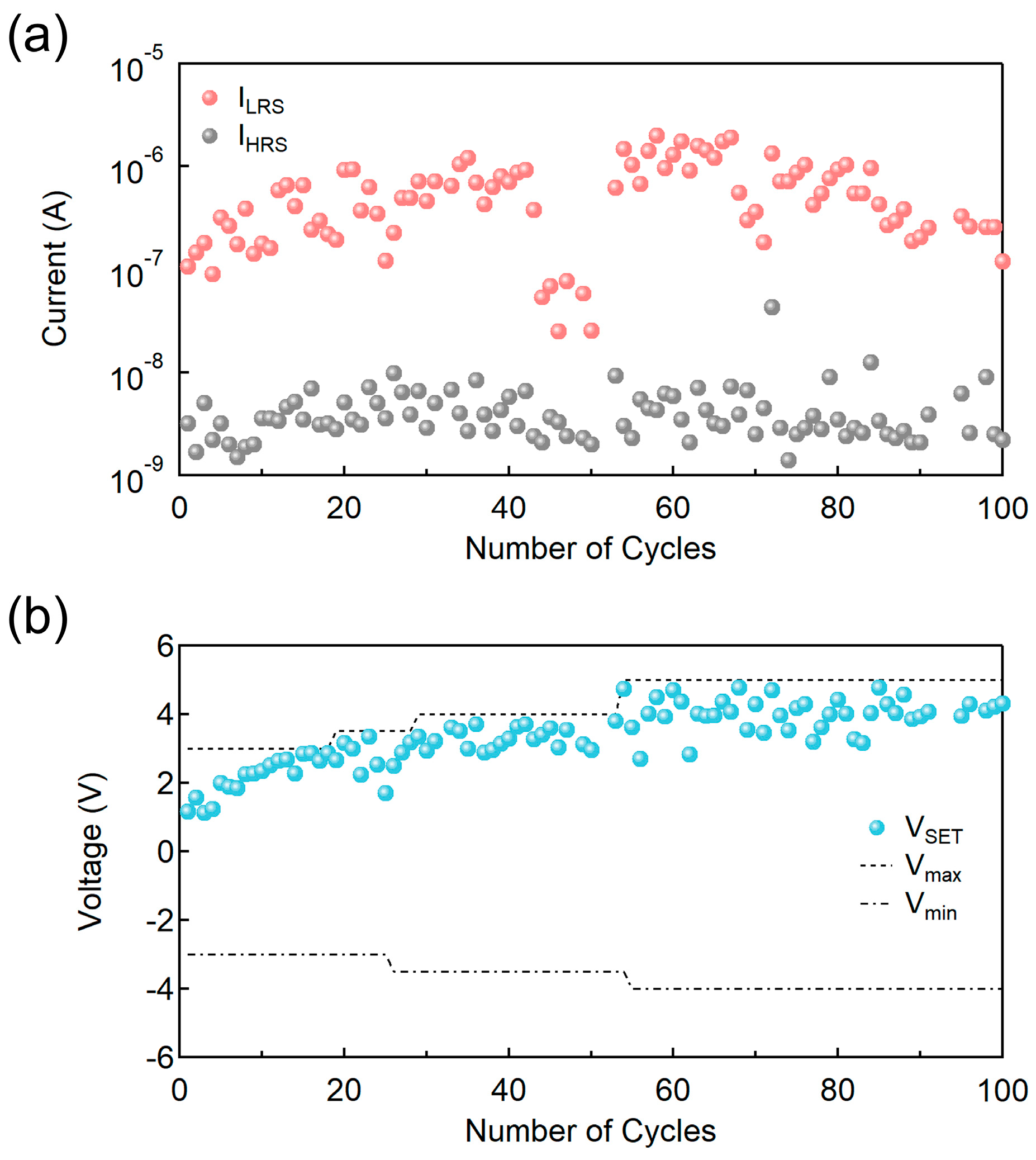
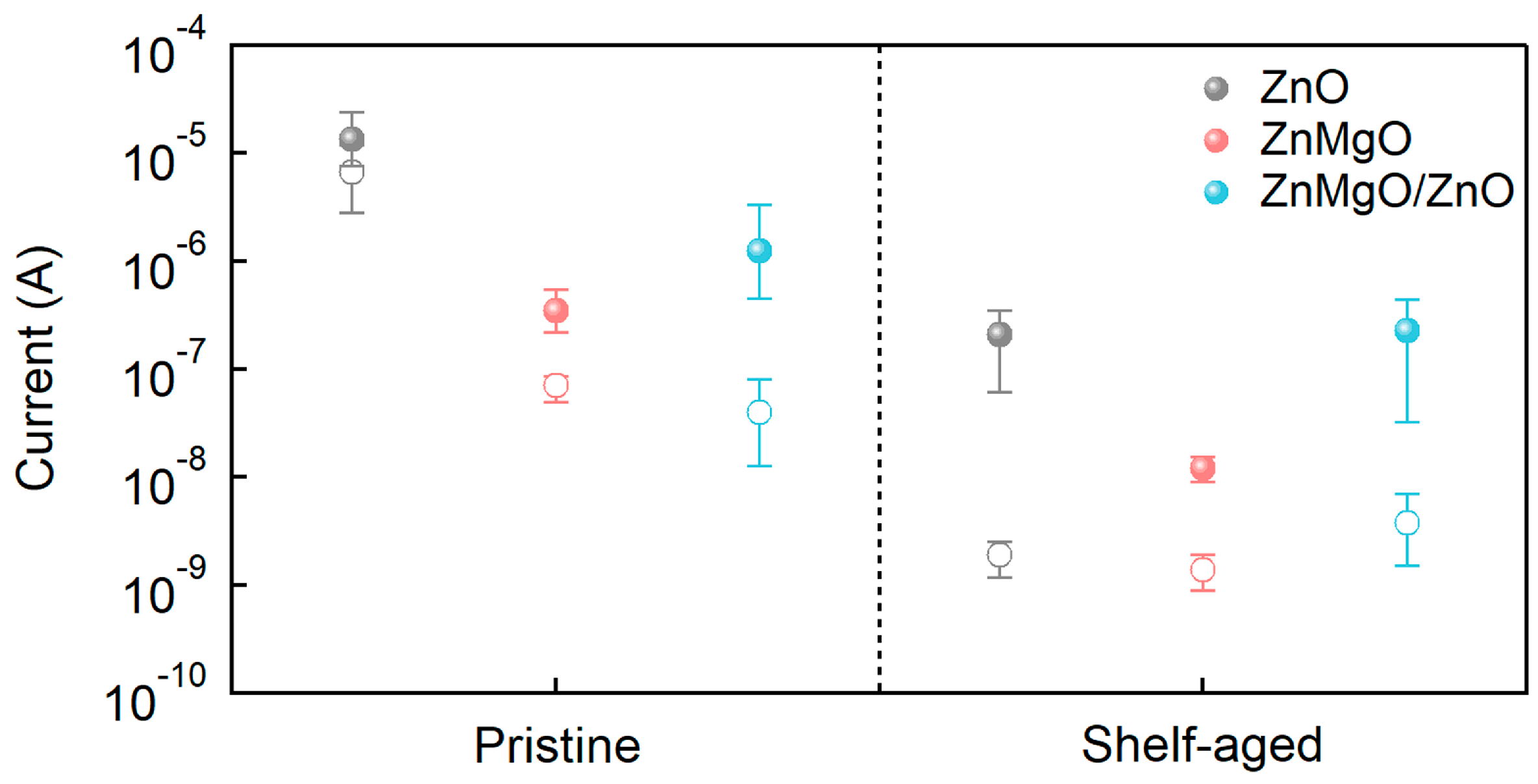
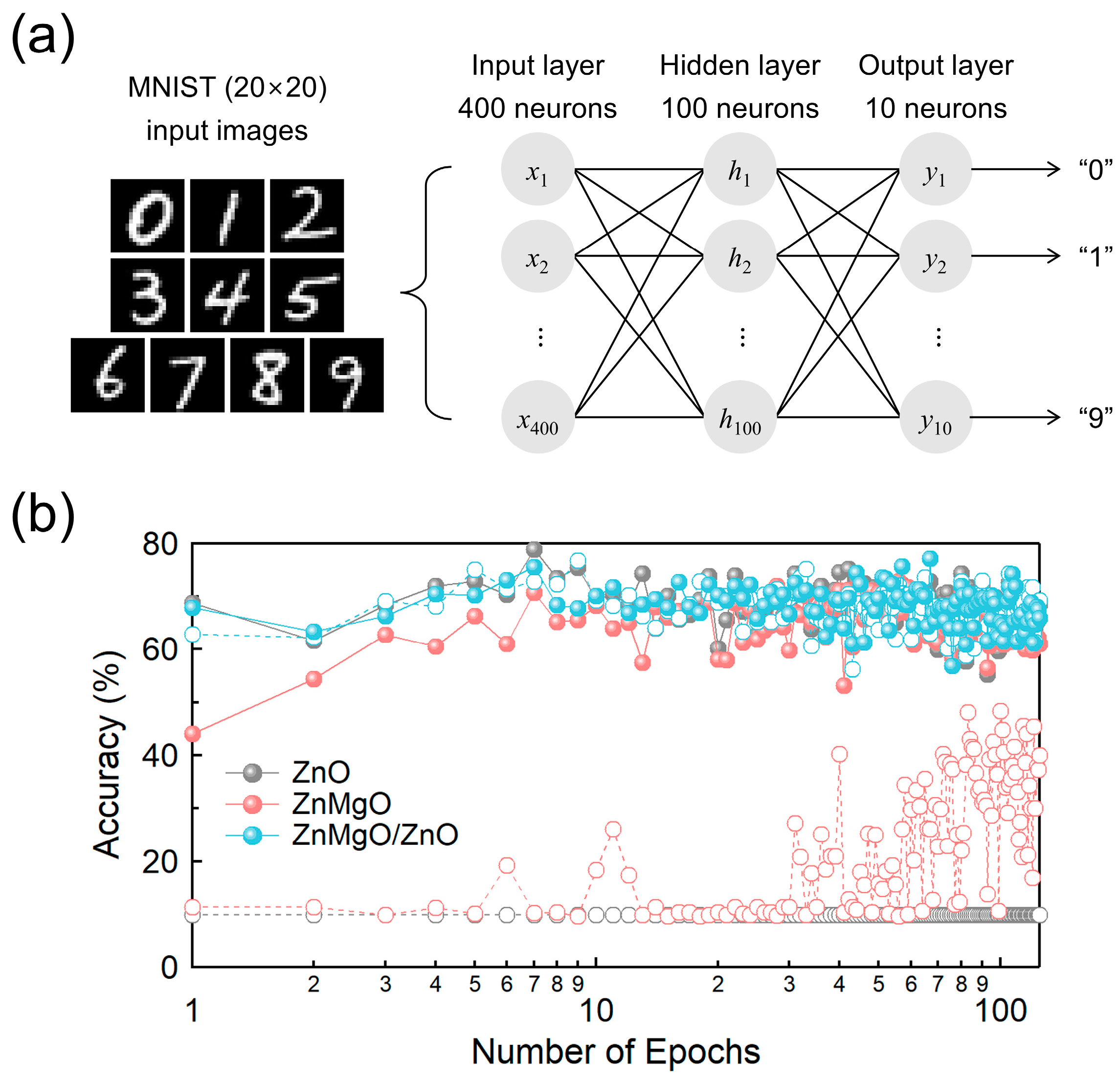
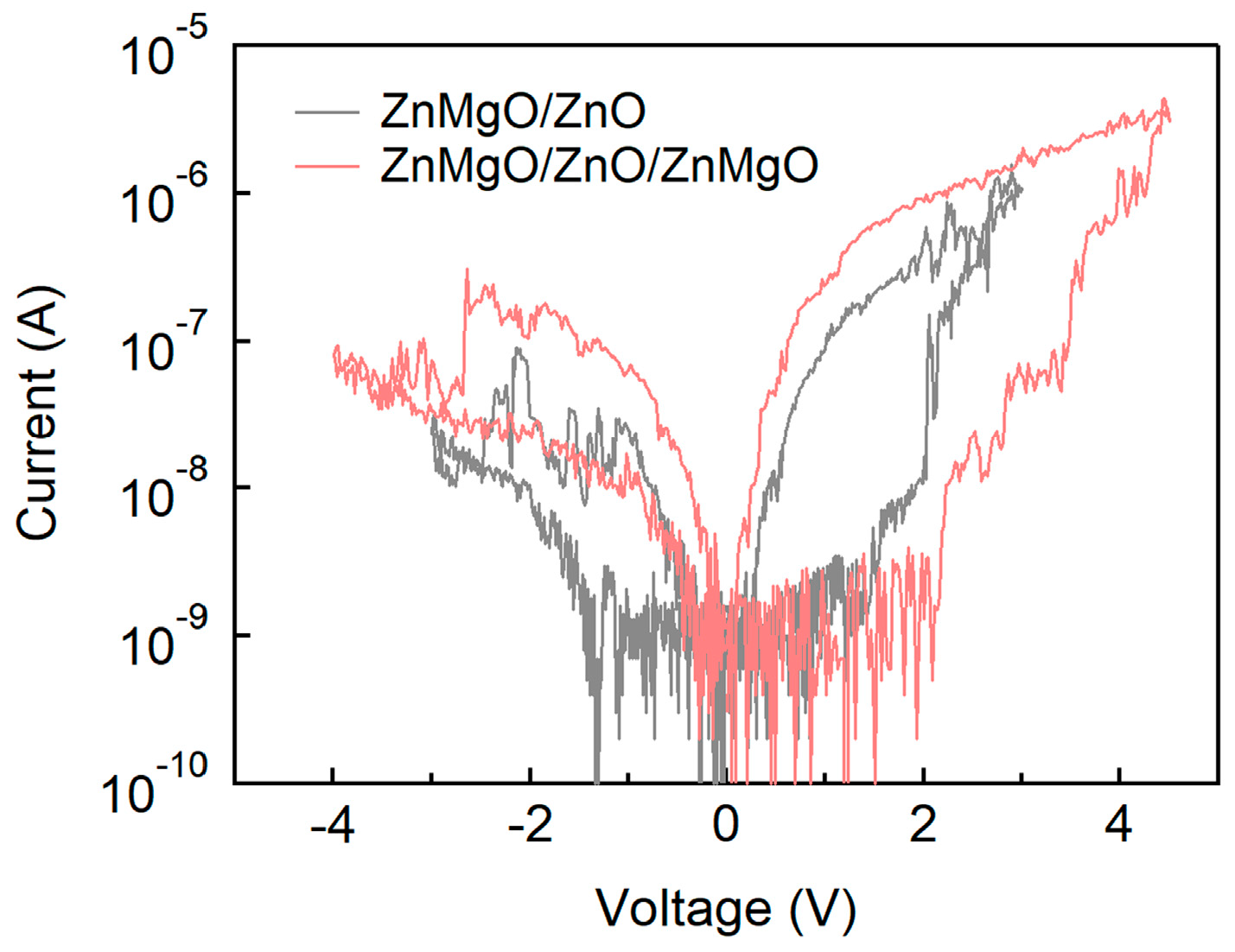
Disclaimer/Publisher’s Note: The statements, opinions and data contained in all publications are solely those of the individual author(s) and contributor(s) and not of MDPI and/or the editor(s). MDPI and/or the editor(s) disclaim responsibility for any injury to people or property resulting from any ideas, methods, instructions or products referred to in the content. |
© 2025 by the authors. Licensee MDPI, Basel, Switzerland. This article is an open access article distributed under the terms and conditions of the Creative Commons Attribution (CC BY) license (https://creativecommons.org/licenses/by/4.0/).
Share and Cite
Shin, H.S.; Kim, D.H.; Lee, D.; Kim, J. Resistive Switching Behavior of Sol–Gel-Processed ZnMgO/ZnO Bilayer in Optoelectronic Devices. Nanomaterials 2025, 15, 1353. https://doi.org/10.3390/nano15171353
Shin HS, Kim DH, Lee D, Kim J. Resistive Switching Behavior of Sol–Gel-Processed ZnMgO/ZnO Bilayer in Optoelectronic Devices. Nanomaterials. 2025; 15(17):1353. https://doi.org/10.3390/nano15171353
Chicago/Turabian StyleShin, Hee Sung, Dong Hyun Kim, Donggu Lee, and Jaehoon Kim. 2025. "Resistive Switching Behavior of Sol–Gel-Processed ZnMgO/ZnO Bilayer in Optoelectronic Devices" Nanomaterials 15, no. 17: 1353. https://doi.org/10.3390/nano15171353
APA StyleShin, H. S., Kim, D. H., Lee, D., & Kim, J. (2025). Resistive Switching Behavior of Sol–Gel-Processed ZnMgO/ZnO Bilayer in Optoelectronic Devices. Nanomaterials, 15(17), 1353. https://doi.org/10.3390/nano15171353





